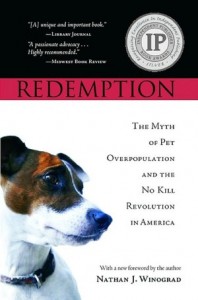TICA Trend Book Review - REDEMPTION: The Myth of Pet Overpopulation and the No Kill Revolution
REDEMPTION: The Myth of Pet Overpopulation and the No Kill Revolution in America
by Nathan Winograd
Trade Paperback 2007
Almaden Books
www.almadenbooks.com
ISBN: 978-0-9790743-0-1
Rating: 5 paws (out of 5)


Redemption is not an easy book, but it’s an crucial one. It’s full of information, and for those who love animals, it’s important information. At this moment in time, with legislation concerning the number of pets we own and breed increasing daily, understanding what motivates the opposition in this complex issue is one of the keys to beating them. But be prepared for some pain along the way-some in the form of statistics, but most in the realization of how many animals could have been saved, if shelters changed the way they were doing things. Most of the book is an in-depth explanation of the following quote: “In the final analysis, animals in shelters are not being killed because there are too many of them, because there are too few homes, or because the public is irresponsible. Animals in shelters are dying for primarily one reason-because people in shelters are killing them.”
Redemption is divided into several sections-it begins with a history of animal sheltering in the United States, starting with the birth of the “humane society” in the 19th century as one man’s compassionate vision. It chronicles the movement as a whole, showing how it slowly went wrong and somehow began to focus on killing animals rather than saving them, finally ending up where we are now.
It explains how the blame was shifted from animal control agencies to the public and the animals themselves, through initiatives like “LES”-Legislation, Education, and Sterilization. LES supports laws to license cats and dogs, animal limit laws, required spay/neuter, legal prohibitions on the feeding of feral cats and gives animal control broad seizure powers. Shelters weren’t taking the next step, however, and providing low cost spay/neuter options, nor were they trying to reduce shelter deaths. They were too busy pointing fingers.
It details the first success story in American sheltering-when Richard Avanzino took over the San Francisco SPCA and began implementing programs aimed at saving lives rather than just abiding by the status quo. Policy changes during his tenure would eventually lead to no healthy animals being killed in San Francisco, and greatly reduce overall shelter deaths.
And it’s the story of a man, Nathan Winograd, who saw the success of No Kill in San Francisco, and took the lessons learned there to upstate New York, where as Director of the Tompkins County SPCA he built on the success of San Francisco to create the first No Kill community in America. Later, he would move on to found the No Kill Advocacy Center, with a goal of creating a No Kill nation.
It lists the steps needed to achieve No Kill, and where and how it worked-in urban American, in rural America, in the South, etc. and how various programs can lead the way there. It tells you what you can do to help.
There are a lot of amazing ideas put forth in this book, and I urge anyone who loves animals to read it. There are several key concepts that Nathan goes back to again and again. One is that No Kill is achievable if the people involved believe in it and work with a goal of saving lives. Another is that the building blocks of No Kill are simple, and that each piece helps: volunteering at the shelter, feral cat trap-neuter-return, spay/neuter before adoption, fostering, breed rescue, etc. These building blocks are things that individuals can contribute to, each according to their abilities, resources, time, etc. We can all help.
This is a very personal book for me, for a number of reasons. I lived in Tompkins County until a few years ago, and was very aware of the issues facing the SPCA, and the problems they had with funding. In the early 1990s, the Tompkins County SPCA was handling both dog and cat control for the county, with the towns funding some of the dog control. Everything else was paid for by donations. A task force was formed to look into licensing cats as a revenue stream to fund cat control. I sat on that task force. Ultimately, the task force recommended against licensing as a revenue stream-but we discussed many of the same issues brought up in Redemption. I met Nathan when he first became Director at the SPCA, and had a front-row seat as many of the events described in the book happened.
Later, when Redemption was first published, Nathan came back to Tompkins County, and spoke at the SPCA as one of the stops on his book tour. He is a fine speaker, and is both passionate and knowledgeable about animals and the No Kill Revolution.
I make no claim to being impartial about this one-my copy of Redemption is personally inscribed. Highly, highly recommended.
Mirrored from Until Midnight and Occasionally Later.